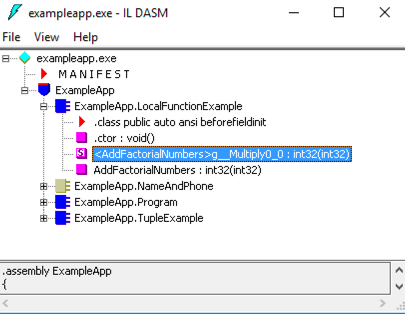C# 7 Additions – Local Functions
In C# 7 it is now possible to create a function within a function termed a Local Function. This is for instances where a second function is helpful, but it’s not really needed in the rest of the class. It’s created just like regular functions except in the middle of another function.
public static int AddFactorialNumbers (int number)
{
int Multiply (int innerNumber)
{
return (innerNumber == 1) ? 1 : innerNumber * Multiply(innerNumber - 1);
}
return Multiply(number);
}
Just like normal functions, you can create expression bodied members as well
int Multiply (int innerNumber) =>
(innerNumber == 1) ? 1 : innerNumber * Multiply(innerNumber - 1);
Local variables in the outer functions are accessible, and it’s possible to embed local functions inside other local functions:
public static string MakeFirstCharacterUpperCase(string name)
{
string MakeUpperCase()
{
string JoinString(IEnumerable<char> array) => String.Join("", array);
return name[0].ToString().ToUpper() + JoinString(name.Skip(1));
}
return MakeUpperCase();
}
So how does it work? Looking at the IL code, the compiler has converted the internal function into a private static one inside the class.

The name is generated at compile time, so it is not accessible to other methods, but it is still possible to access it through reflection with the private and static binding flags.

Someone I know asked what would be a good use case of Local Functions vs. Lambdas. Lambdas can’t contain enumerators, and by encasing an enumerations in a local function it allows others parts of the outer method to be eagerly evaluated. For example, if you have a method which takes a parameter and returns an enumeration, the evaluation of the parameter won’t occur until program starts to enumerate the collection. Encapsulating the enumeration in a local function allows the other parts of the outer function to be eagerly evaluated. You can find an example of the difference between using one and not using one here.